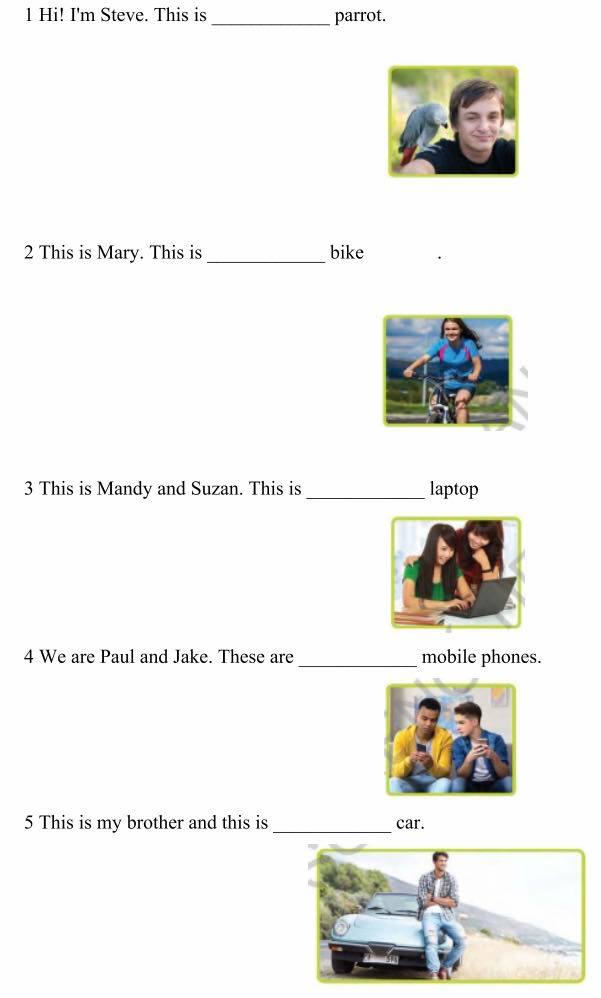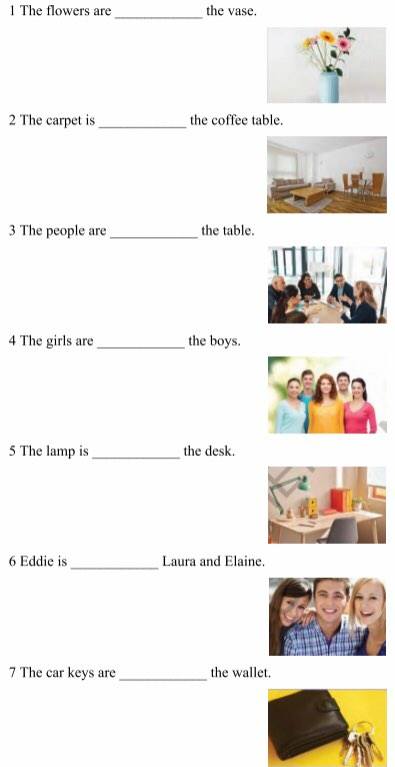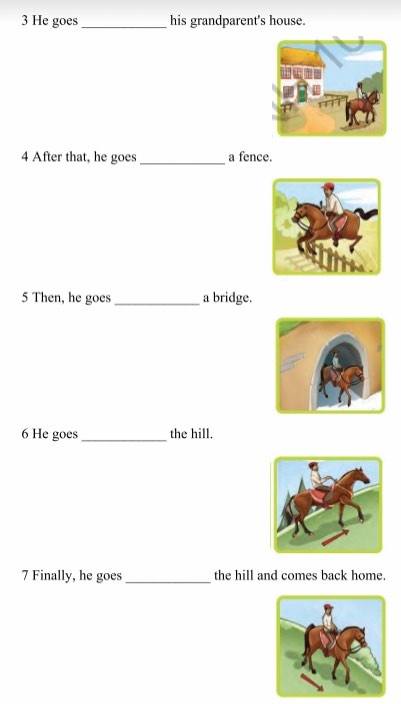Grammar Bank Section (1-13) - SBT Tiếng Anh 10 Bright1. Fill in each gap with you, me, he, she, their or it.2. Complete the sentences with the correct possessive adjectives.3. Complete the school rules using the correct imperative form of the verbs below. 4.Complete the email with the correct form of the verb to be.5. Look at the table. Write sentences as in the example.6. Complete the sentences using the correct form of the verb to be and have got.7. Look at the picture. Complete the sentences with there is, there isn't, there are or there aren't Lựa chọn câu để xem lời giải nhanh hơn Bài 1 1. Fill in each gap with you, me, he, she, their or it. (Điền vào chỗ trống với you, me, he, she, their or it.) 1 Look at that puppy. ____________ is so cute. 2 I'm new here. Can ____________ tell me how to get to room C4? 3 Eric is in the school band. ____________ plays the guitar 4 The players have got new football kits. ____________ football kits are very modern. 5 This is Mary. ____________ is my best friend. Phương pháp giải:
Lời giải chi tiết:
1 Look at that puppy. It is so cute. (Nhìn con chó con đó. Nó thật dễ thương.) 2 I'm new here. Can you tell me how to get to room C4? (Tôi là người mới ở đây. Bạn có thể cho tôi biết làm thế nào để đến phòng C4?) 3 Eric is in the school band. He plays the guitar (Eric là trong ban nhạc của trường. Anh ấy chơi đàn ghi-ta) 4 The players have got new football kits. Their football kits are very modern. (Các cầu thủ đã có bộ dụng cụ bóng đá mới. Bộ dụng cụ bóng đá của họ rất hiện đại.) 5 This is Mary. She is my best friend. (Đây là Mary. Cô ấy là bạn thân nhất của tôi.) Bài 2 2. Complete the sentences with the correct possessive adjectives. (Hoàn thành các câu sau bằng việc sử dụng các tính từ sở hữu.)
Phương pháp giải:
Lời giải chi tiết:
1 Hi! I'm Steve. This is my parrot. (Xin chào! Tôi là Steve. Đây là con vẹt của tôi.) 2 This is Mary. This is her bike (Đây là Mary. Đây là chiếc xe đạp của cô ấy). 3 This is Mandy and Suzan. This is their laptop (Đây là Mandy và Suzan. Đây là máy tính xách tay của họ) 4 We are Paul and Jake. These are our mobile phones. (Chúng tôi là Paul và Jake. Đây là điện thoại di động của chúng tôi.) (Đây là anh trai tôi và đây là xe của anh ấy.) Bài 3 3. Complete the school rules using the correct imperative form of the verbs below. (3. Hoàn thành các quy tắc của trường bằng cách sử dụng hình thức mệnh lệnh đúng của các động từ dưới đây.) • make • be • listen • keep • throw • run • write • eat SCHOOL RULES 1 ____________ on time. 2 ____________ in the corridors. 3 ____________ all electronic devices in your schoolbag. 4 ____________ to your teacher. 5 ____________ in class. 6 ____________ on your desk . 7 ____________ noise. 8 ____________ litter in the bin. Phương pháp giải: Make (v): làm Listen (v): nghe Keep (v): giữ Throw (v): ném Run (v): chạy Write (v): viết Eat (v): ăn Lời giải chi tiết:
1 Be on time. (Luôn đúng giờ) 2 Don’t run in the corridors. (Không chạy trong hành lang) 3 Keep all electronic devices in your schoolbag. (Giữ các thiết bị điện tử trong cặp của bạn) 4 Listen to your teacher. (Lắng nghe cô giáo của bạn) 5 Don’t eat in class. (Không ăn trong lớp học) 6 Don’t write on your desk . (Không viết ra bàn) 7 Don’t make noise. (Không tạo tiếng ồn) 8 Throw litter in the bin. (Ném rác vào thùng) Bài 4 4.Complete the email with the correct form of the verb to be. (Hoàn thành email với dạng đúng của động từ tobe) Hi Jenny, I 1) ____________ Fabio and I 2) ____________ 15 years old. My birthday 3) ____________ on the 28 February. My best friend and I 4) ____________ in the same football team but he 5) ____________ faster than me. His name 6) ____________ Marco. He 7) ____________ 14 years old. His birthday 8) ____________ on the 15th April. What about you? Where 9) ____________ you from? Who 10) ____________ your best friend? Write soon. Fabio Phương pháp giải: *Tobe: (+) S+ am/is/are + …….. (-) S+ am/is/are + not + …… (?) Tobe + S + N/Adj? Lời giải chi tiết:
Hi Jenny, I 1) am Fabio and I 2) am 15 years old. My birthday 3) is on the 28 February. My best friend and I 4) are in the same football team but he 5) is faster than me. His name 6) is Marco. He 7) is 14 years old. His birthday 8) is on the 15th April. What about you? Where 9) are you from? Who 10) are your best friend? Tạm dịch: (Xin chào Jenny, tôi 1) là Fabio và tôi 2) 15 tuổi. Sinh nhật của tôi 3) là vào ngày 28 tháng Hai. Bạn thân nhất của tôi và tôi 4) ở cùng một đội bóng đá nhưng anh ấy 5) nhanh hơn tôi. Tên của anh ấy 6) là Marco. Anh ấy 7) 14 tuổi. Sinh nhật của anh ấy 8) là vào ngày 15 tháng 4. Thế còn bạn? 9) bạn đến từ đâu? Ai 10) là bạn thân nhất của bạn?) Bài 5 5. Look at the table. Write sentences as in the example. (Nhìn vào bảng. Viết các câu theo mẫu sau)
1 Emma has got a tablet and a bike, but she hasn't got a mobile phone. 2 _____________________________________________________________. 3 _____________________________________________________________. Phương pháp giải: Have got: có, là chủ sở hữu (+) S + have/has got + objects (-) S + have/has + not + got + objects. (?) What + have/has + S + got? Lời giải chi tiết: 2 Brenda & Katie have got a tablet and a mobile phone, but they haven't got a bike. (Brenda và Katie có 1 chiếc máy tính bảng và 1 chiếc điện thoại, nhưng họ không có xe đạp.) 3 Tim has got a bike and a mobile phone, but he hasn't got a tablet. (Tim có 1 chiếc xe đạp và 1 chiếc điện thoại, nhưng anh ấy không có máy tính bảng.) Bài 6 6. Complete the sentences using the correct form of the verb to be and have got. ( Hoàn thành các câu bằng cách sử dụng dạng đúng của động từ to be và have got.) 1 James ____________ twenty years old. 2 We ____________ a car, so we take the bus. 3 Martha ____________ long black hair. 4 I ____________ two sisters. They are twins. 5 My cousins ____________ from Spain. They ____________ French 6 Your new room ____________ very big. It ____________ a balcony, too. Phương pháp giải: *Tobe: (+) S+ am/is/are + …….. (-) S+ am/is/are + not + …… (?) Tobe + S + N/Adj? Have got: có, là chủ sở hữu (+) S + have/has got + objects (-) S + have/has + not + got + objects. (?) What + have/has + S + got? Lời giải chi tiết:
1 James is twenty years old. (James 20 tuổi) 2 We haven’t got a car, so we take the bus. (Chúng tôi không có ô tô vậy nên chúng tôi bắt xe buýt) 3 Martha has got long black hair. (Martha có bộ tóc đen dài) 4 I have got two sisters. They are twins. (Tôi có 2 người chị. Họ là chị em sinh đôi) 5 My cousins aren’t from Spain. They are French (Các anh em họ của tôi không phải người Tây Ban Nha. Họ là người Pháp) 6 Your new room is very big. It has got a balcony, too. (Phòng mới của bạn thật to. Nó cũng có ban công nữa.) there is/ there are Bài 7 7. Look at the picture. Complete the sentences with there is, there isn't, there are or there aren't. (Nhìn vào bức tranh. Hoàn thành câu với there is, there isn’t, there are hoặc there aren’t)  1 ____________ some books on the shelf. 2 ____________ a lamp on the desk. 3 ____________ any posters on the walls, but there is a painting 4 ____________ a ball on the floor. 5 ____________ three pillows on the bed. 6 ____________ a rug on the floor. Phương pháp giải: - There is=there's và There are=there're dùng để giới thiệu rằng có cái gì, ai đó hoặc ở đâu trong HIỆN TẠI There is - Khẳng định: There is + danh từ không đếm được (uncoutable nouns) hoặc danh từ số ít (plural nouns)+ trạng ngữ (nếu có) - Phủ định: There is not (there isn't) + any + danh từ không đếm được (uncountable nouns) hoặc danh từ số ít (singular nouns) + trạng ngữ (nếu có) Lưu ý - Trước danh từ số ít cần dùng A, AN, THE - Trước danh từ không đếm được không dùng a/ an nhưng có thể thêm NO (không), A LITTLE (một ít), LITTLE (ít), MUCH (nhiều), A LOT OF (nhiều) There are There are + danh từ số nhiều (singular nouns) + trạng ngữ (nếu có) Khẳng định: There are + danh từ số nhiều (singular nouns) + trạng ngữ (nếu có) Phủ định: There are not (there aren't) + danh từ số nhiều (plural nouns) + trạng từ (nếu có) Lời giải chi tiết: 1 There are some books on the shelf. (Có một số cuốn sách trên giá.) 2 There is a lamp on the desk. (Có một cái đèn trên bàn làm việc.) 3 There aren’t any posters on the walls, but there is a painting (Không có bất kỳ áp phích nào trên tường, nhưng có một bức tranh) 4 There isn't a ball on the floor. (Không có bóng trên sàn.) 5 There are three pillows on the bed. (Có ba cái gối trên giường.) 6 There is a rug on the floor. (Có một tấm thảm trên sàn nhà.) Bài 8 8. Choose the correct option. (Chọn đáp án đúng.) 1 A: How much/How many money do you want for the cinema? B: Not a lot of/much. 2 A: There aren't many/much tomatoes left. B: I can buy any/some on my way home. 3 A: Do you want sugar in your tea? B: Just a few/a little, please. 4 A: Are there much/many bananas in the fruit bowl? B: No, but there are a lot of/much pears. 5 A: How much/How many eggs do you need for the cake? B: Not many/much. Just two or three. 6 A: Is there many/much ice cream in the freezer? B: Yes, there's a lot/a lots. 7 A: Can I invite a little/a few of my friends over for dinner? B: Of course. Phương pháp giải: How many/How much (bao nhiêu) How many ĐT tobe: How many + danh từ đếm được số nhiều (Plural Noun) + are there? ĐT thường: How many + danh từ đếm được số nhiều + do/ does/ did + S + have? How much: ĐT tobe: How much + danh từ không đếm được (uncountable noun) + is there? Động từ thường: How much + danh từ không đếm được (uncountable noun) + do/does/ did + S + V? Lời giải chi tiết:
1 A: How much/How many money do you want for the cinema? B: Not a lot of/much. (1 A: Bạn muốn bao nhiêu tiền cho rạp chiếu phim? B: Không nhiều.) 2 A: There aren't many/much tomatoes left. B: I can buy any/some on my way home. (2 A: Không còn nhiều cà chua. B: Tôi có thể mua một ít trên đường về nhà.) 3 A: Do you want sugar in your tea? B: Just a few/a little, please. (3 A: Bạn có muốn đường vào trà của mình không? B: Chỉ một chút thôi, làm ơn.) 4 A: Are there much/many bananas in the fruit bowl? B: No, but there are a lot of/much pears. (4 A: Có bao nhiêu quả chuối trong bát quả? B: Không, nhưng có rất nhiều lê.) 5 A: How much/How many eggs do you need for the cake? B: Not many/much. Just two or three. (5 A: Bạn cần bao nhiêu quả trứng cho chiếc bánh? B: Không nhiều. Chỉ hai hoặc ba.) 6 A: Is there many/much ice cream in the freezer? B: Yes, there's a lot/a lots. (6 A: Có nhiều kem trong tủ đông không? B: Vâng, có rất nhiều) 7 A: Can I invite a little/a few of my friends over for dinner? B: Of course. (7 A: Tôi có thể mời một vài người bạn của mình đến ăn tối không? B: Tất nhiên.) Bài 9 9. Choose the correct option. (Chọn đáp án đúng.) 1 A: Whose/Who's your favourite actor? B: James McAvoy 2 A: What/Which time is your lesson? B: At half past six 3 A: How/What long does the meeting last? B: Two hours 4 A: Where/Why do you work? B: At the local cinema 5 A: What/Who is your favourite sport? B: Football 6 A: Why/When does the show start? B: In 20 minutes 7 A: Whose/Who's dog is this? B: I think it's Janice's. 8 A: How often/far do you practice playing the piano? B: Every day Phương pháp giải:
Lời giải chi tiết:
1 A: Whose/Who's your favourite actor? B: James McAvoy 1 A: Diễn viên yêu thích của bạn là ai? B: James McAvoy 2 A: What/Which time is your lesson? B: At half past six 2 A: Giờ học của bạn là mấy giờ? B: Lúc sáu giờ rưỡi 3 A: How/What long does the meeting last? B: Two hours 3 A: Cuộc họp kéo dài bao lâu? B: Hai giờ 4 A: Where/Why do you work? B: At the local cinema 4 A: Bạn làm việc ở đâu? B: Tại rạp chiếu phim địa phương 5 A: What/Who is your favourite sport? B: Football 5 A: Môn thể thao yêu thích của bạn là gì? B: Bóng đá 6 A: Why/When does the show start? B: In 20 minutes 6 A: Khi nào chương trình bắt đầu? B: Trong 20 phút nữa 7 A: Whose/Who's dog is this? B: I think it's Janice's. 7 A: Con chó của ai đây? B: Tôi nghĩ đó là của Janice. 8 A: How often/far do you practice playing the piano? B: Every day 8 A: Bạn thường tập chơi piano bao lâu một lần? B: Mỗi ngày Bài 10 10. Fill in each gap with in front of, around, on, between, in, next to or under. (Điền vào mỗi khoảng trống với in front of, around, on, between, in, next to hoặc under.)
Phương pháp giải: In front of phía trước Around xung quanh On trên Between giữa In trong Next to bên cạnh Under dưới Lời giải chi tiết:
1 The flowers are in the vase. (1 Những bông hoa trong bình.) 2 The carpet is under the coffee table. (2 Tấm thảm dưới bàn cà phê.) 3 The people are around the table. (3 Những người đang ở quanh bàn.) 4 The girls are in front of the boys. (4 Các cô gái ở trước các chàng trai.) 5 The lamp is on the desk. (5 Đèn trên bàn làm việc.) 6 Eddie is between Laura and Elaine. (6 Eddie ở giữa Laura và Elaine.) 7 The car keys are next to the wallet. (7 Chìa khóa xe cạnh ví.) Bài 11 11. Fill in each gap with across, up, down, under, along, past or over. (Điền vào mỗi khoảng trống với across, up, down, under, along, past hoặc over.) One Saturday morning Tom goes horse riding.
Phương pháp giải: Across băng qua Up lên Down xuống Under dưới Along dọc theo Past vừa qua Over kết thúc Lời giải chi tiết:
1 He rides his horse along the forest. (Anh ta cưỡi ngựa đi dọc khu rừng.) 2 Then, he goes across the path. (Sau đó, anh ta đi ngang qua con đường.) 3 He goes past his grandparent's house. (Anh ấy đi ngang qua nhà ông bà anh ấy.) 4 After that, he goes over a fence. (Sau đó, anh ta đi qua một hàng rào.) 5 Then, he goes under a bridge. (Sau đó, anh ta đi dưới một cây cầu.) 6 He goes up the hill. (Anh ta đi lên đồi.) 7 Finally, he goes down the hill and comes back home. (Cuối cùng, anh ta đi xuống đồi và trở về nhà.) Bài 12 12. Put the verbs in brackets into the Present Simple or the Present Continuous. (Dùng các động từ trong ngoặc ở thì Hiện tại đơn hoặc Hiện tại tiếp diễn.) 1 I usually ____________ (shop) at the local, but today I'm going (go) to the shopping centre. 2 John ____________ (walk) to school, but today he is taking (take) the bus. 3 We always ____________ (clean) the house together. 4 I ____________ (not/play) football today, because I have a terrible headache. 5 The children ____________ (play) video games right now. 6 Mike never ____________ (mop) the floor. Phương pháp giải:
Lời giải chi tiết:
1 I usually shops at the local, but today I'm going to the shopping centre. (1 Tôi thường mua sắm ở địa phương, nhưng hôm nay tôi sẽ đến trung tâm mua sắm.) 2 John walks to school, but today he is taking the bus. (2 John đi bộ đến trường, nhưng hôm nay anh ấy bắt xe buýt.) 3 We always clean the house together. (3 Chúng tôi luôn cùng nhau dọn dẹp nhà cửa.) 4 I am not playing football today, because I have a terrible headache. (4 Hôm nay tôi không chơi bóng vì tôi bị đau đầu kinh khủng.) 5 The children are playing video games right now. (5 Bọn trẻ đang chơi trò chơi điện tử ngay bây giờ.) 6 Mike never mops the floor. (6 Mike không bao giờ lau sàn.) Bài 13 13. Put the verbs in brackets into the Present Simple or the Present Continuous. (Đặt các động từ trong ngoặc ở thì Hiện tại đơn hoặc Hiện tại tiếp diễn.) 1 A: My mum ____________ (be) a nurse. B: Really? ____________ (she/work) in a hospital? 2 A: Where ____________ (you/go) now? B: To the robot club. The competition ____________ (start) at 9:00. 3 A: What time ____________ (the mall/usually/close)? B: At 9:00, but today it ____________ (stay) open until 10:00. 4 A: They ____________ (study) hard these days. B: I know. They ____________ (want) to do well in their exams. Phương pháp giải:
Lời giải chi tiết:
1 A: My mum is a nurse. B: Really? Does she work in a hospital? (1 A: Mẹ tôi là một y tá. B: Thật không? Cô ấy có làm việc trong bệnh viện không?) 2 A: Where are you going now? B: To the robot club. The competition starts at 9:00. (2 A: Bạn đang đi đâu bây giờ? B: Đến câu lạc bộ robot. Cuộc thi bắt đầu lúc 9h00.) 3 A: What time does the mall usually close? B: At 9:00, but today it stays open until 10:00. (3 A: Trung tâm mua sắm thường đóng cửa lúc mấy giờ? B: Lúc 9:00, nhưng hôm nay nó vẫn mở cửa đến 10:00.) 4 A: They are studying hard these days. B: I know. They want to do well in their exams. (4 A: Họ đang học tập chăm chỉ trong những ngày này. B: Tôi biết. Họ muốn làm tốt trong kỳ thi của họ.)
|


















